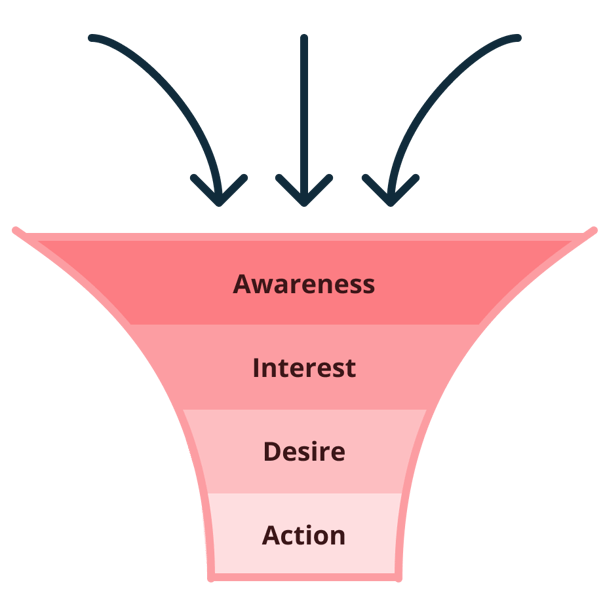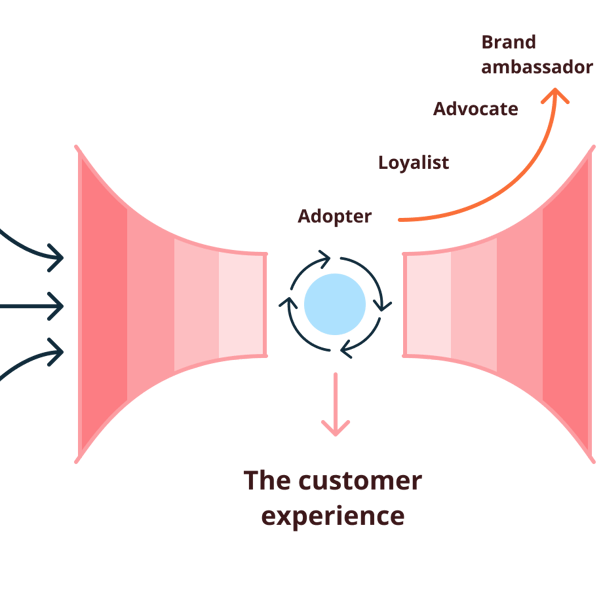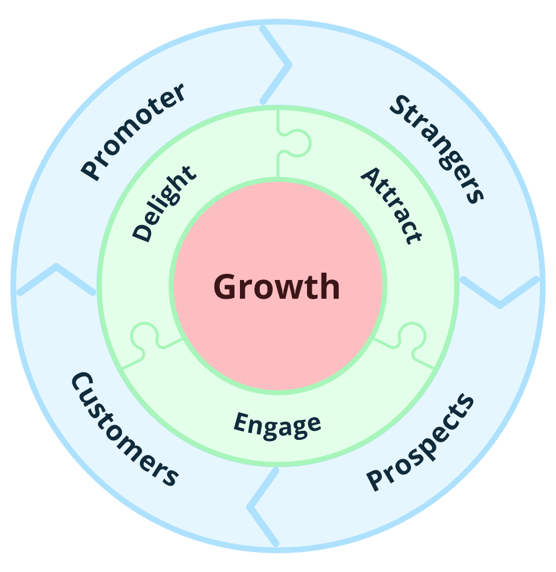-
 Written by Sean Dougherty
Written by Sean DoughertySenior Brand Creative at Funnel, Sean has more than 15 years of experience working in branding and advertising (both agency and client side). He's also a professional voice actor.
You may have heard people report the traditional sales funnel is dead, but according to industry leaders, that statement is far from true—well, depending on who you ask, of course! While the traditional sales and marketing funnel has changed over the decades, it remains crucial for marketers aiming to understand and influence customer journeys.
Those who disregard the potential of their sales and marketing funnels miss out—especially those who ignore the value of marketing funnel metrics. Data shows nearly 70% of companies have not attempted to measure the effectiveness of their sales and marketing funnels. Many believe today's process is too complex, and by not optimizing their funnel's potential, they aren't achieving the expected results. This disconnect often contributes to the "funnels are dead" debate.
User engagement isn't as straightforward as a decade ago, let alone a century when the funnel concept was born. The key is modernizing the marketing funnel and adjusting your strategy as technology evolves and your business grows. This in-depth guide explores the ins and outs of the marketing funnel, helping you determine the best funnel model for your marketing campaigns and overall business. -3.png?width=1200&height=800&name=Funnel%20(1)-3.png)
Quick summary
Not sure this is the article for you? Let me give you the short version. Marketing funnels: they're not dead—they’ve just evolved. Understanding how people actually move through today’s messy customer journeys can help you create a smarter, more adaptable funnel that drives real results.
In this guide, we’ll walk you through:
-
What a marketing funnel is (and why it still matters)
-
Why traditional funnels need a modern refresh
-
Expert takes on the future of funnels
-
How to spot and fix gaps in your funnel
-
Practical tips for building a funnel that reflects today’s buying behavior
Key takeaway:
Funnels still work—but the best ones are flexible, customer-driven, and always evolving.
What are sales and marketing funnels?
Sales and marketing funnels, also known as purchase or conversion funnels, are terms that describe the customer journey—spanning from prospecting to paying customers. These funnels include several steps, which vary based on your sales model. Funnels are like tailored marketing suits. There is no one-size-fits-all approach, and as new funnel types are developed, you may need to adjust, re-strategize, and adapt.
Well-built funnels guide customers through the buying process—and those without gaps are the most successful, regardless of the model. When gaps do exist, potential customers drop out of the sales process. Picture water (representing customers) flowing out of the holes of a sieve (the gaps) instead of flowing through a solid funnel. The more solid your funnel and associated marketing approach, the greater your sales and opportunities for repeat business. -3.png?width=1200&height=460&name=brief%20quote%20(1)-3.png)
The evolution of the marketing funnel
The concept of marketing funnels has been around for more than 100 years — and since its inception, the basics of the model have remained relatively unchanged. However, as the years passed, new models were developed. The industry began to see no single model is universally ideal for all companies. Digital marketing also played a significant role in this transformation. While the AIDA model was the first of its kind, developed in 1898 by St. Elmo Lewis, it is just one of the marketing funnels used today.
Several variations exist, and companies are not limited to just one model or analysis concept. You can blend concepts from core marketing and sales strategies with newer models to move leads along your funnel and prevents losing customers.
So, don't get caught up on one model—a marketing funnel shouldn't be static. Again, this is where data, testing, and marketing funnel metrics come into play. Don't be afraid to experiment, especially if your current funnel isn't converting as expected. Don't give up. Instead, pivot and adapt.
Different marketing funnels exist for varying purposes
Marketing funnels come in endless shapes and sizes. Many exist, each offering pros and cons based on the desired use case. Many models are also flexible in that you can rename or add stages, like an advocacy or loyalty stage.
While flexibility exists between models, all marketing funnels' functions remain, regardless of the specific stages you add—attract, engage, and convert. The journey you take your customers on may differ as you uncover what makes them tick, but the core objectives will stay the same. In that sense, the traditional marketing funnel lives on in all models.
Explore these marketing funnel options to achieve optimal digital marketing success.
AIDA model
The AIDA model—Attention, Interest, Desire, Action—first gained traction in the door-to-door sales era. This linear model was developed to help salespeople encourage a purchase within a single interaction. This model remains a cornerstone of modern marketing and is based on the four categories it's named after. Consumers move from a broad group (cold leads) to a smaller target audience (hot leads).
Since this model was always linear in nature, many refer to it as the dying funnel—or at least one that is outdated based on the influence of digital and the scope of marketing data. Regardless, the philosophy of this model is a logical approach and remains to some extent in all others. It has stood the test of time—it just needs a bit of tweaking. It continues to act as a blueprint, and as long as you're willing to invest in data analysis and adapt, it remains a valuable model.

The classic AIDA model focuses on prospective customers
REAN
Originally developed in 2006, this four-factor framework stands for Reach, Engagement, Activation, and Nurture. The goal is to raise awareness, improve interactions, retain and re-engage, and a call to action. REAN is used for mapping and analyzing marketing activities. Like most of the newer funnels, developing with digital in mind, REAN can be adapted to many marketing efforts, including mapping channels, planning frameworks, and strategy development.
.png?width=1200&height=605&name=REAN%20(1).png)
TOFU, MOFU, BOFU
TOFU, MOFU, and BOFU each represent a marketing funnel stage:
- Top of the funnel (TOFU) — This is the awareness stage.
The top of the funnel focuses on generating awareness and attracting potential customers to the brand, product, or service. Leads at this stage are often referred to as leads or general prospects - Middle of the funnel (MOFU) — This is the consideration stage.
In the middle of the funnel, potential customers who have shown interest and are actively considering their options are called marketing qualified leads (MQLs). These are prospective customers who have been identified by marketing efforts as potentially interested in the product or service based on certain criteria or behaviors. - Bottom of the funnel (BOFU) — This is the conversion stage.
The bottom of the funnel is the final stage of the buyer's journey, where potential customers have almost made a decision. Leads at this stage are often referred to as Sales Qualified Leads (SQLs) or opportunities, as they have been further qualified by the sales team and are ready to be converted into customers.
These components each offer unique features and an associated content marketing strategy. TOFU initiates the customer's journey by generating interest, MOFU aims to nurture leads, and BOFU strives to convert potential customers into actual customers.
Based on where customers are within this three-stage process will determine your content marketing strategy. For example, those in the TOFU stage may benefit from educational content that helps build brand awareness and trust. In contrast, those in the MOFU stage will seek content that helps them better evaluate their options. Finally, save persuasive content for those in the BOFU stage.
Bowtie
This model considers the stages before the purchase and focuses on post-purchase stages like loyalty and advocacy. Unlike the traditional marketing funnel, which primarily focuses on acquiring new customers, the bowtie model is beneficial because it doesn't neglect existing customers and, more importantly, loyal customers. If you want to enhance customer retention and build lasting relationships, consider pulling elements from this cone-shaped funnel.

The Bowtie model can mean investing equally in loyalty programs as initial awareness
Flywheel
HubSpot adapted the Flywheel model to showcase the momentum you experience once you align your organization around delivering an excellent customer experience. When leveraging happy customers to become brand advocates, drive repeat sales and referrals, your business keeps spinning. Prospects turn into customers and eventually become promoters through customer testimonials and personalization. Instead of a linear funnel, this model is a circular process where repeat customers encourage growth.

The Flywheel encourages customers to become brand advocates
See, Think, Do, Care
Google developed the See, Think, Do, Care model, which is a typical KPI framework often used as a sales or content marketing funnel. The ultimate goal is to attract customers using a customer-centric approach. Consider this model when aiming to better understand consumers through a multi-channel approach.
Building a funnel vs. the marketing funnel
Understanding the difference between "building a funnel" and "the marketing funnel" is vital for anyone looking to master the art of funnel marketing. While building a funnel focuses on the practical application and customization of a sales strategy, the marketing funnel provides a foundational framework that informs those efforts.
Building a funnel
Building a funnel refers to the hands-on process of constructing a specific pathway or strategy to guide potential customers through stages of engagement. It's a tactical approach that can be tailored to a particular product, service, or audience. Whether designing a lead generation strategy or creating a conversion pathway, building a funnel is about the actionable steps to convert prospects into customers.
The marketing funnel
In contrast, the funnel marketing is a broader concept representing the general stages a consumer goes through before making a purchase decision. From awareness to consideration to conversion, the marketing funnel is a theoretical model that helps marketers understand customer behavior and plan their strategies accordingly. Marketers can use key insights to decide which activities and marketing channels will guide the customer toward a purchase.
Recommended: What is marketing analytics?
What do the experts say?
So, what do some of the leading voices in marketing have to say when asked whether marketing funnels are still relevant and important? Here's a deep dive into some individuals and teams who have kept their finger on the pulse for all things related to marketing funnel models — traditional and emerging.
Tom Roach
Tom Roach has more than 20 years of experience as a marketing and communications strategist. His article, The sales funnel is wrong but it's here to stay, so let's fix it, focuses on the following:
- Despite reports of the marketing funnel death, this concept has never been more alive as it adapts to its environment. However, to continue going for decades, it must adapt to today's media environment, leaning on marketing and advertising science. Marketers must adapt alongside it.
- While the marketing funnel is more than a century old, it wasn't until the 2000s and 2010s that its popularity rose. Tom believes the growth of ad tech platforms influenced this rise.
- Some of the criticisms of the marketing funnel include its lack of post-purchase or loyalty relevance. However, this can be adjusted by adding additional marketing funnel stages and a loop to earlier ones. Another consideration is that funnels are too linear and that, in the real world, it's more of a complicated web of touchpoints.
- The standard funnel is built around three basic layers – awareness, consideration, and conversion — which aren't overly accurate or reliable. Forcing people through a journey isn't realistic, but nudging them is. Plus, everything must be seen as a performance and brand-building contribution — not just the bottom of the funnel. So, the three standard layers could be modified to include building, nudging, and connecting.
.png?width=1152&height=460&name=Tom%20quote%20(1).png)
Mark Ritson
Mark Ritson, a brand consultant and former marketing professor, wrote an opinion-based article titled, Mark Ritson: If you think the sales funnel is dead, you've mistaken tactics for strategy.
Here's what he had to say on the subject:
- Reports of the death of sales funnels are exaggerated. He recounts an article by Jason John, the chief marketing officer at Publishers Clearing House. John talks about his experience purchasing a new coffee maker, stating that the once clean, straightforward sales funnel process no longer exists. Today, shoppers jump in and out of channels while searching for the best deal. Ritson disagrees.
- Ritson says that John focused too much on the tactical resources and attempts of brands to influence instead of the most important point of the sales funnel — the customer's journey.
- Before cinema ads, television, direct mail, the Internet, and smartphones, the sales funnel existed. Yes, these technologies altered the tactical options available to marketers. However, the value of a well-built funnel remains unchanged.
.png?width=1152&height=460&name=Mark%20quote%20(1).png)
Think with Google - Alistair Rennie and Jonny Protheroe
Like Tom, two authors working on Google's consumer insights team shared their research on the buyer decision process in an article titled, How people decide what to buy lies in the “messy middle” of the purchase journey. Here's what they shared:
- What happens between trigger and purchase decision-making isn't linear. The way people make decisions is "messy" — and will only get messier. In response to the Internet's growth, purchase behavior has changed. It has become a tool to compare everything, apparent based on Google Search data. Consumers are making decisions in an online environment of limitless information and abundant choice. So, how do they decide what to buy?
- While conducting extensive research, this team formed an updated decision-making model. The "messy middle" is at its core, with two mental nodes — exploration and evaluation. People loop through these while looking at a category's products and brands. This looped cycle repeats until a purchasing decision is made.
- Hundreds of possible cognitive biases shape shopping outcomes. However, the team prioritized the following six: category heuristic (short product descriptions simplify decisions); power of now (longer wait times weaken propositions); social proof (reviews are highly persuasive); scarcity bias (availability influences desirability); authority bias (being swayed by an expert); and power of free (free gifts are strong motivators).
- These biases were formed following a shopping experiment with real in-market shoppers simulating 310,000 purchase scenarios across retail, financial services, travel, utilities, and consumer packaged goods.
- To succeed, you should give shoppers the information and reassurance they need. A compelling proposition, a closed gap between the trigger and purchase, a strong brand presence, and a flexible team that can work cross-functionally can help you boost the efficiency and success of your model.
Advice for marketers
There's plenty to consider when aiming to upgrade your current funnel-based marketing strategy. Here are some fresh tips, sourced from the Funnel marketing department:
1. Focus on the customer journey
Regardless of which funnel model you use, you should always understand the customer journey. If you can map the journey and understand pain points, you know where to put your time and attention.
Take what you've learned from a traditional sales and marketing funnel and lifecycle marketing to develop a more modern, comprehensive strategy. So, instead of the customer journey ending after a purchase, incorporate loyalty and advocacy stages within the bottom of your funnel. Invest in your customers, ensuring that their journey continues post-purchase.
After all, if you can reduce your churn rate by just 5%, you can increase profitability by 25-125%. You can then reinvest those profits to optimize your strategy even further.
2. Look at the data
A significant part of modernizing your marketing and sales funnel is the metrics and data you track. To measure the success of your marketing funnel, you'll require qualitative (how people experience your marketing funnel and their customer journey) and quantitative data (e.g., numerical figures). Doing so will help you better understand how consumers shop and behave.
Remember, your marketing funnel should be designed based on how customers buy — not how you want to sell.
As you gain insight, you can optimize your marketing funnel based on your knowledge of the customer journey to increase conversions. You can then implement content and other marketing materials to guide prospects, such as targeted landing pages.
So, to bring your quantitative and qualitative data together, focus on the following:
- Heatmaps to better understand consumer behavior and optimize your website.
- Funnels to pinpoint where users are dropping off and can help you compare the conversion rates of varying channels.
- Session recordings to see how real users engage with your site and identify potential pain points.
- Survey to obtain valuable feedback and discover what's stopping customers from converting. You can also survey customers who did convert to better understand what does work.
Read more: Marketing data tools you can't live without
3. Optimize and adapt
Regularly review and adapt your marketing tactics in response to changing consumer behaviors, market dynamics, and performance data.
To ensure ongoing success, you'll need a plan that considers tried and true practices, quality data, and consumers' changing needs. Always be mindful of possible bottlenecks where you lose leads and test new strategies, such as A/B tests. Optimize your strategies through the power of analytics and adapt your digital marketing based on those insights.
Metrics to measure your funnel’s success
Of course, if you want to stay on top of the data to measure how well your funnel is working, you're going to need to define the metrics you want to measure. To truly optimize your marketing funnel, you need to track the right metrics at every stage.
Here are some key metrics you could keep an eye on:
-
Conversion rates: How many people are moving from one stage of the funnel to the next?
-
Drop-off rates: Where are people falling out of the journey? Identifying drop-off points helps you patch leaks fast.
-
Customer acquisition cost (CAC): How much are you spending to acquire each new customer? A rising CAC could point to inefficiencies in your funnel.
-
Lead-to-customer rate: What percentage of your leads actually become paying customers?
-
Average time to conversion: Is your funnel fast and frictionless, or are prospects getting stuck?
-
Return on ad spend (ROAS): Are your paid efforts actually driving profitable outcomes?
📍Don’t just track these metrics in isolation. Look at how they trend over time and across different channels to spot bigger opportunities for optimization.
Tools to build and optimize a better funnel
Ready to get your funnel set up and start measuring and optimizing? Don't miss out on the best tools to help you succeed. The right tools can help you understand your funnel performance, close gaps, and scale faster.
Here are a few essentials:
-
Analytics platforms (like Funnel.io and Google Analytics): Get a full view of your marketing performance and track every stage of your funnel.
-
Behavior tracking tools (like Hotjar): Understand how people actually move through your site—where they click, scroll, and drop off.
-
CRM platforms (like HubSpot): Manage leads and customers throughout their journey and personalize their experience.
-
Automation tools (like Mailchimp): Nurture leads with targeted email sequences that keep them moving forward.
-
A/B testing tools (like Optimizely): Experiment with different messaging, layouts, and offers to see what really drives conversions.
A strong funnel isn’t just about getting people in the door—it’s about constantly improving the entire journey, from first touch to final purchase (and beyond).
Get started with a funnel that makes sense for your business
And finally, don't get too caught up in the headlines and opinions of others. While there is plenty of room for improvement when looking at the traditional sales and marketing funnel in today's digital economy, your objective remains. Get closer to your customers — understand their needs and meet them.
Also read: how marketing and sales teams can work better together.
As Steve Jobs said, "Get closer than ever to your customer. So close that you tell them what they need well before they realize it themselves." Access to data-driven insights and flexible funnel models makes that more possible than ever. Lean on the tools you need to design, implement, and optimize a marketing funnel that aligns with your specific business objectives and customer needs. Do that, and you can ignore the "funnel is dead" background chatter.
-
 Written by Sean Dougherty
Written by Sean DoughertySenior Brand Creative at Funnel, Sean has more than 15 years of experience working in branding and advertising (both agency and client side). He's also a professional voice actor.
